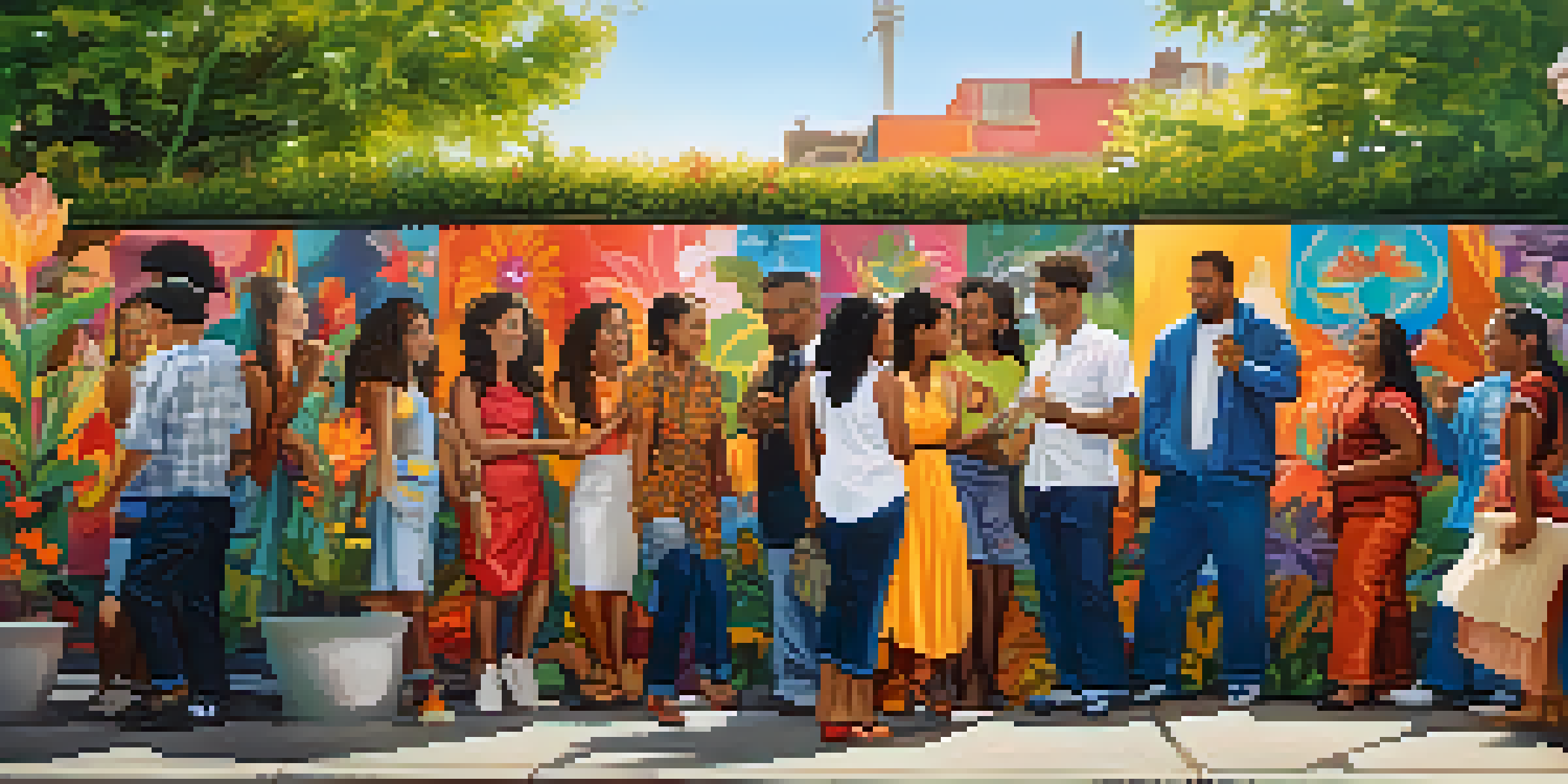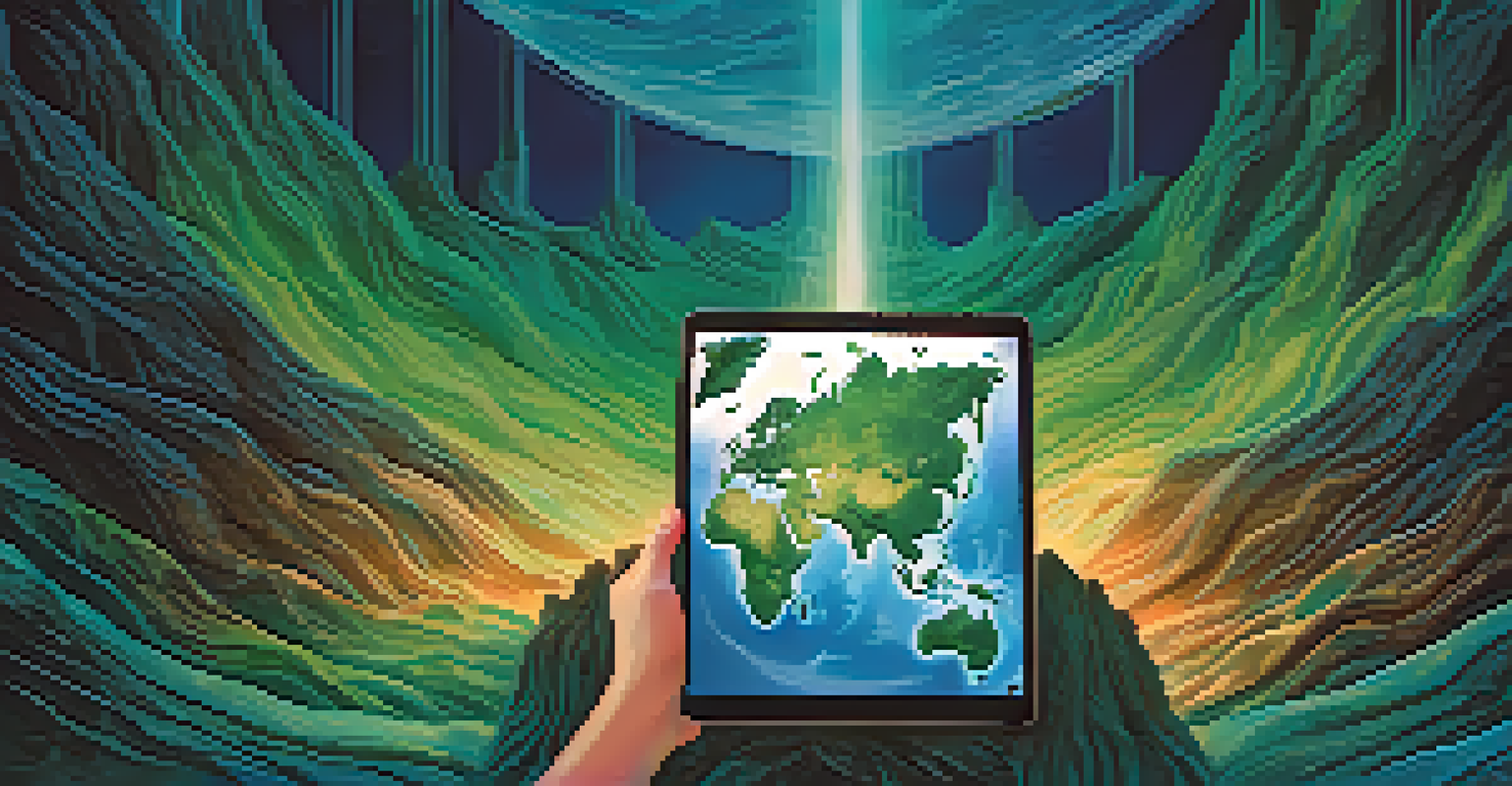Narratives of Marginalization: Painting and Social Justice

Understanding Narratives of Marginalization in Art
Narratives of marginalization often reflect the voices of those who feel excluded from mainstream society. Through painting, artists express their experiences and the struggles faced by marginalized communities. This form of visual storytelling can evoke empathy and provoke thought, making it a powerful medium for social change.
Art is the most beautiful of all lies.
Art becomes a platform for these narratives, offering a space for dialogue and reflection on social injustices. For instance, works by artists like Kehinde Wiley highlight the experiences of Black individuals in a historically white-dominated art world. By centering marginalized voices, these paintings challenge viewers to confront uncomfortable truths.
Moreover, the emotional resonance of these narratives can inspire action. When viewers see their stories represented in art, it fosters a sense of connection, encouraging them to advocate for change within their communities. Thus, the intersection of art and social justice becomes a vital arena for transformation.
The Role of Painting in Social Justice Movements
Throughout history, painting has played a pivotal role in social justice movements, serving as a visual record of protests and struggles. Artists often use their work to comment on political issues, amplifying messages that might otherwise go unheard. For example, the murals of Diego Rivera in Mexico not only depict the struggles of the working class but also celebrate their resilience.

In contemporary contexts, street art has emerged as a powerful form of expression, capturing the urgency of social movements like Black Lives Matter. Artists paint murals that address systemic racism and police brutality, transforming urban spaces into galleries of activism. These visual statements serve as both memorials and calls to action.
Art Amplifies Marginalized Voices
Through visual storytelling, artists express the experiences and struggles of marginalized communities, fostering empathy and inspiring social change.
By creating art that resonates with current social issues, painters can mobilize communities and inspire collective efforts toward change. Such artworks become more than just images; they serve as catalysts for conversations and movements, leading to a more informed and engaged public.
Art as a Reflection of Cultural Identity
Art is not only a medium for social commentary but also a reflection of cultural identity. For many marginalized groups, painting serves as a means to reclaim and celebrate their heritage. Artists draw upon their cultural narratives to create works that resonate with their communities and validate their experiences.
Art should comfort the disturbed and disturb the comfortable.
For instance, Indigenous artists often incorporate traditional symbols and stories into their paintings, fostering a sense of pride and continuity. This cultural expression can counteract the erasure of history and identity experienced by marginalized populations. Through their work, these artists lay claim to their narratives and assert their place in the broader societal context.
Additionally, the act of sharing these cultural narratives through art promotes understanding and appreciation among diverse audiences. It opens the door for dialogue about cultural nuances and shared humanity, bridging gaps between different communities and fostering solidarity.
Using Art to Challenge Stereotypes and Misconceptions
Art has the unique ability to challenge stereotypes and misconceptions that often perpetuate marginalization. Through painting, artists can confront societal norms and present alternative narratives that defy common stereotypes. This process of redefinition encourages viewers to rethink their assumptions about marginalized communities.
Consider the work of Frida Kahlo, whose self-portraits delve into themes of identity and gender. By presenting her own struggles, she challenges prevailing notions of femininity and beauty, paving the way for discussions about gender norms. These visual narratives empower individuals to embrace their complexities rather than conform to societal expectations.
Painting Fuels Social Justice Movements
From historical murals to contemporary street art, painting serves as a powerful medium for documenting protests and advocating for social justice.
When artists present a more nuanced view of marginalized groups, they contribute to breaking down barriers of misunderstanding. This shift in perception can foster greater compassion and acceptance, ultimately leading to a more equitable society.
Collaborative Art Projects and Community Engagement
Collaborative art projects can significantly enhance community engagement by bringing together diverse voices to address social justice issues. These initiatives allow artists and community members to co-create works that reflect shared experiences and aspirations. The collective nature of this process fosters a sense of ownership and pride among participants.
For example, community murals often involve local residents in the design and painting process, allowing them to express their stories visually. This not only beautifies public spaces but also strengthens community bonds. By working together, participants can create a sense of belonging and shared purpose.
Moreover, these collaborative projects often serve as a platform for dialogue, where community members can discuss their experiences and challenges. This exchange of ideas can lead to a deeper understanding of social issues and inspire collective action toward change.
The Impact of Digital Art on Social Justice Narratives
In today's digital age, artists are leveraging technology to amplify their social justice messages in innovative ways. Digital art, including graphic design and social media campaigns, allows for rapid distribution and engagement with broader audiences. This accessibility can transform individual narratives into global movements.
Platforms like Instagram and TikTok have become vital spaces for artists to share their work and connect with like-minded individuals. For instance, digital illustrations that address issues such as climate change and racial injustice can quickly go viral, sparking conversations and mobilizing action. These digital narratives reach beyond geographical boundaries, uniting people around shared causes.
Digital Art Expands Social Impact
In the digital age, artists use technology to reach wider audiences, transforming individual narratives into global movements for social justice.
Furthermore, the interactive nature of digital art invites viewer participation, blurring the lines between artist and audience. This engagement fosters a community of advocates who are inspired to take action, demonstrating the power of art in shaping public discourse on social justice.
Conclusion: The Future of Art and Social Justice
As we look to the future, the relationship between art and social justice will continue to evolve. Artists will undoubtedly find new ways to express the narratives of marginalized communities, utilizing emerging technologies and platforms to amplify their voices. This ongoing dialogue between art and social issues is crucial for fostering awareness and inspiring change.
Moreover, as society grows more diverse, the importance of inclusive narratives in art becomes even more pressing. Artists have a unique responsibility to ensure that their work reflects the complexities of the human experience. By doing so, they can contribute to a more equitable and just society.

Ultimately, the power of painting as a tool for social justice lies in its ability to connect us all. Through shared stories and experiences, we can cultivate empathy, understanding, and a collective desire for a better world.